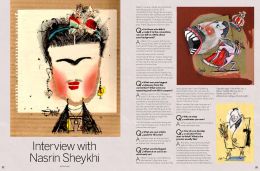Nasrin Sheykhi Interview
 | |
| Author | Tom Faraci |
|---|---|
| Subject | Nasrin Sheykhi |
| Genre | Article, Interview |
| Published | EF Issue 2019.2 |
Publication date | Spring 2019 |
| Media type | Digital |
| Pages | 22-24 |
| Website | caricature |
Article Description. Should include author, brief description, issue number and page number(s).
Article Transcript
Nasrin, it was an honor and a pleasure to have you join us at the ISCA convention in San Diego! Because your seminar was a late addition, we weren’t able to include you in the pre-con issue of the magazine. Thank you for doing this interview with us and letting us use your Frank Zappa piece for the cover.
Q: For those who didn’t make it to the convention, can you tell us a little about your background?
A: Well, I’m a 29 year-old Persian visual artist, born in 1989 in Iran and couldn’t talk until 3 years of age. I was beginning to paint at that time and after a while I could speak. I was educated at the Fine Art University of Shiraz. People know that city for Shiraz wine, but wine is illegal in that country. Shiraz is the capital of art and culture of Iran. I created my own art style in caricature, and before that I had a lot of challenges to know what I wanted to do, so I was researching in all different art styles and then I could find my way.
Q: What was your biggest takeaway from the convention? What were you expecting and how did it compare?
A: When I was in Iran, I followed the ISCA convention and I knew that artists were going to gather somewhere to work and obviously have fun. It was interesting for me to see the convention in person which was so cool. I met a lot of great artist friends and that communication was very valuable for me and I was pleased to be able to introduce myself to them in my seminar. I think that the convention was great and I hope to experience more of the convention next year.
Q: What are your artistic goals for this year?
A: Create more art and get more familiar with this new society of caricature that I immigrated to.
Q: What was the biggest influence on you as an artist early on?
A: When I was 15, I was following Sebastian Krüger and Jean Mulatier who were classic caricaturists, and 4 years later I loved following some South American caricaturists who were so creative. At the same time, I was following classic and modern artists in painting and other fields of art like architecture, music. When I wanted to create my own art style, I was influenced by native art and children because they were so pure and brave.
Q: Who or what motivates you now?
A: The reality that I should not stop is my motivation now.
Q: How do you develop a caricature from start to finish? What’s the process usually like?
A: To start, I need to find a person to caricature, which is always a celebrity. It must be someone that is interesting because my next move is researching and living with that personality to understand them. Then I start to sketch to understand the face composition and shapes. After that, I start to extract as much information as I need. But usually my technique is based on the subject of the caricature.
Q: What piece that you’ve done means the most to you and why?
A: Each piece has different meaning for me and it’s not possible to choose one.
Q:Do politics often factor into your art? Is that a path you’d like to keep pursuing?
A: I am not a political artist, but I am a critical artist and do devote attention to all different fields in this world, like music, society, the environment, and politics is one of those fields. Honestly, politics has the least value in my life, and that’s why I painted my political caricatures at 2x2 inches and just spend 15 minutes of my life on them.
Q: As for your musician caricatures, what is it that draws you to them as a subject? Did you have the same kind of access to rock music in Iran that we do in the US?
A: Fortunately, media and Internet made this world very small and we all can have access to anything we want, which means we can share our ideas and cultures and art. I was raised in the technological age. I was watching the same cartoons and was listening to the same music.
I had access to many different music from different countries. I was most interested in listening to rock music because, mentally, I could make a connection with that style. The thing that I loved from old classic rock was its concept of freedom in lyric and music and how free they are to express themselves without any fear.
Q: Are there any projects you’re working on now that you can share with us?
A: They all are at the same level ... not finished yet. The way that I work on my projects is a bit weird, maybe because I am working at 12 paintings at the same time and they all are done 80 percent together and they will be done at the same time.
Q: Where can people find you and your work?
A: I’m living in New York City now and people can find my paintings on my social media accounts and my website.
Instagram: nasrinsheykhiart Website: www.nasrinsheykhi.art
Image Slideshow
See Also
External Links
This Navigation box may not show up on mobile browsers. Please see Exaggerated Features Issue 2019.2 for the full contents of this issue if the navigation box does not display.





